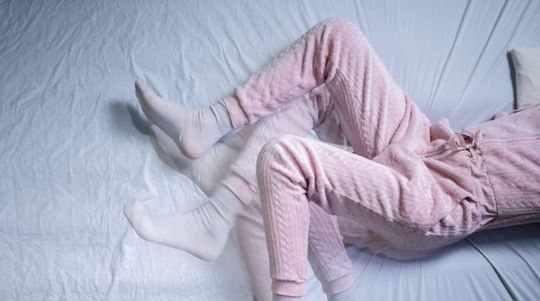When you go to bed at night, do you ever have the impulse to kick or move your legs constantly? Restless Leg Syndrome is very likely to affect you (RLS).
Consider the situation of a 30-year-old young man who couldn't sleep at night because he couldn't stop moving his legs. He was not only sleep deprived and fatigued, but also irritable and irritated at work, to the point where he was afraid of losing his job.
After meeting Dr. Bobby Jose, a specialist neurologist and medical director at NMC Hospital in Sharjah, he was prescribed light medication for diabetic neuropathy and told to do yoga and get leg massages. The young man noticed a significant improvement in his sleep and a decreased desire for restless shuffling of his lower limbs after combining holistic treatments.
Getting the proper diagnosis
"RLS is a complex illness that can easily be confused with diabetic neuropathy or Parkinson's Disease," Dr Jose stated, explaining the etymology in depth.
Iron deficiency causes the same symptoms in youngsters. As a result, having a thorough history and analysis of the symptoms is critical in confirming the diagnosis.
What causes RLS to occur?
"RLS is caused by a breakdown in the neuronal pathways of the brain's basal ganglia that provide the hormone dopamine," he explained.
This is partly due to genetics, such as a family history of RLS in first to third degree relatives, but it could also be caused by stress and anxiety. Doctors have not been able to discover the gene that is causing this.
Typical symptoms
It causes patients to have a dull discomfort in their lower limbs. Dopamine production usually drops at the end of the day, and patients' sleep patterns are disrupted as a result.
Patients report a crawling sensation in their legs, as well as a dull ache that improves only when shuffled or shaken. Their persistent drive to kick in the air or move their legs stems from the agony and odd sensation they are experiencing. As a result, the quality and duration of their sleep declines, leaving them irritable, restless, and fatigued during the day.
Who is at risk?
Although such neurological abnormalities are more common as people get older, RLS provoked by anxiety and stress can strike anyone at any age.
Due to a lack of appropriate circulation and stress, the illness might appear in the last trimester in pregnant women. The symptoms diminish in children after the iron is restored, and in women after pregnancy.
How to deal with the situation
"While true RLS cannot be cured, it can be treated with a mix of medications that target the dopamine circuit disturbance. Furthermore, a holistic approach to treatment that includes a healthy diet, adequate sleep, yoga, and stress-relieving breathing techniques can significantly reduce the symptoms." Said Dr Jose.
He added that one of the younger patients who had it experienced significant improvement after attending regular yoga courses.
Avoid getting mixed up with other ailments
Dialysis patients with kidney failure have symptoms that are comparable to RLS. They have pain and a burning sensation in their lower limbs, however this is due to inadequate circulation in their lower limbs as a result of renal failure.
A similar scenario occurs in diabetics who have numbness in their lower limbs and loss of sensation in their feet due to a lack of circulation. This is a diabetic neuropathy sufferer who needs better blood sugar control and diabetic care. RLS treatment will not benefit these patients.
People are also concerned that RLS could signal the start of Parkinson's disease. This is also untrue, according to Dr. Jose. Although dopamine synthesis is linked to both PD and RLS, RLS is only induced by a breakdown in dopamine pathways. As a result, RLS and PD are disorders with distinct etymologies and effects.
What can be done?
According to Dr. Azam Badr Khan, a specialist in Orthopaedics and Knee Replacement at Prime Hospital, physiotherapy and massage can enhance circulation and provide an important step in the management of RLS.
"Because RLS is a neurological disorder, any physiotherapy for it must be combined with neurological treatment for the best outcomes," he said.
While physiotherapy cannot cure RLS, a mix of leg massage, hot and cold packs, low vibration gadgets that may be wrapped around the limbs, and a healthier, well-balanced diet can all help reduce symptoms," he noted.
He added that the US Food and Drug Administration has approved a novel wrap-around, low-vibration massager that can be used closer to bedtime to help relieve symptoms and allow patients to sleep better. In any case, if the patient had a good night's sleep, the symptoms will go away on their own.
Dietary factors in RLS improvement
• Include potassium-rich foods in your diet, such as kiwi, bananas, and chia seeds. This can help you sleep better and feel less restless.
• Eat a diet rich in whole foods, fresh fruits, seeds, nuts, and leafy green vegetables.
• Because iron deficiency can cause RLS-like symptoms, eating iron-rich natural foods in your diet will help you feel better.
• Vitamin D insufficiency has been linked to RLS symptoms, according to research. So get enough of early morning sunlight and supplement with Vitamin D if you're low.
• Stay away from fried, high-sugar foods, which can aggravate RLS.
• Avoid a sedentary lifestyle and introduce regular walking and exercise for a minimum of 30 minutes, daily • Yoga and deep breathing can help reduce stress, and since stress has a direct impact on aggravating the symptoms of RLS, it is advisable to incorporate these lifestyle tweaks into your daily routine.
 AR
AR UR
UR
